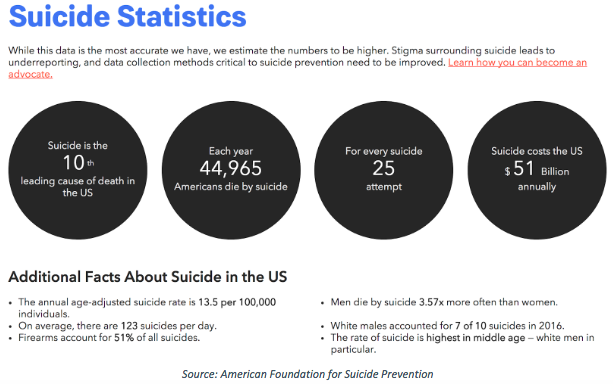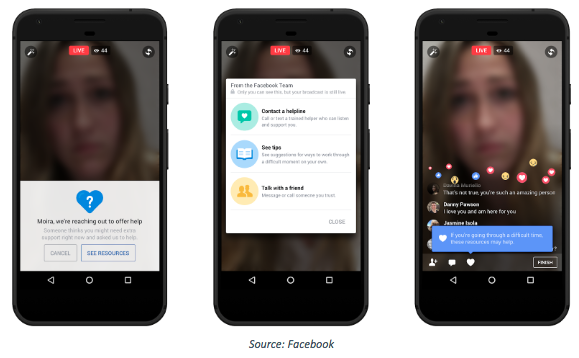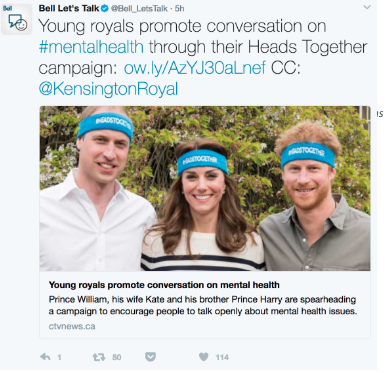In 2017, a 15-year-old girl from Bedford, PA, was trying to live an ordinary teenage life until her classmates began bullying her. They attacked her on social media sites like Facebook and Kik about her red hair and braces, some going as far as telling her that she should kill herself. Her mother remembers finding the young girl sobbing for hours because of what people were saying about her in school and online. Even though her mother took her phone and tried to comfort the girl, less than a week later she would die by suicide.
While the rate of death by suicide among teenage girls is at an all-time high, they’re not the highest risk demographic of the more than
40,000 people who die by suicide in the U.S. each year. According to the CDC,
seven of 10 suicides in 2015 were men,
making men 3.5x more likely than women to die by suicide. Now the third-leading cause of death among adults age 15-44 worldwide, the global rate of suicide will hit 1.53 million per year by 2020, which constitutes
one death by suicide every 20 seconds, according to the World Health Organization.

Children as young as 11 are dying by suicide as a result of experiences on social media, and we know of at least three examples of children broadcasting their own death to live audiences using social media tools such as Facebook live, Twitter and YouTube.
How are leaders responding?
In response to these disturbing trends, Facebook has partnered with organizations like
the National Suicide Prevention Lifeline to develop a set of tools intended to help individuals find resources and support who are considered "at risk" for self-harm.
The first of these tools is a new suicide-prevention feature on Facebook that uses artificial intelligence (AI) to identify posts indicating suicidal or harmful thoughts. The AI scans the posts and their associated comments, compares them with others that merited intervention and, in some cases, passes them along to its community team for review. The company plans to reach out to users it believes are at risk, showing them a screen with suicide-prevention resources including options to contact a helpline or contact a friend.

While in some cases the artificial intelligence software will notify the Facebook community if it flags a situation as “very likely urgent,” in most cases it will simply work in the background to offer messaging and advice to the friends and family of a person in need.
See also: Blueprint for Suicide Prevention
Dr. John Draper, of the National Suicide Prevention Lifeline, said that he feels that the software sounds promising. “If a person is in the process of hurting themselves and this is a way to get to them faster, all the better,” he told BuzzFeed News. “In suicide prevention, sometimes timing is everything.”
Facebook is also making certain suicide prevention organizations available via Facebook Messenger, its instant messaging app. Facebook users will be able to flag posts that they feel indicate "at risk behavior,” which Facebook will respond to with an on-screen option to receive suicide-prevention resources.
Can we use social media to predict suicide?
New research out of Korea suggests that we might be able to begin using social media to predict suicidal behavior.
The three-year study looks at the social and environmental factors that contribute to suicidal behavior and describes correlations between public mood and suicide and how data from social media sources and weblogs (blogs) might be used to predict that behavior; their primary hypothesis being that social media variables are meaningfully associated with nationwide suicide numbers.
At the end of the study, the research team concluded that, “We found a significant association of social media data with national suicide rate, resulting in a robust, proof-of-principle predictive model,” and the team suggests social media data be used in future predictive modeling.
How suicide prevention advocates are using social media.
Sites like the Suicide Prevention Coalition of Colorado, the Mighty and To Write Love on Her Arms are also using social media to engage audiences with messages of help and hope.
The Suicide Prevention Coalition of Colorado, an organization of which the author of this article is a member, uses Facebook, Twitter and email newsletters as educational and communications tools to promote events, raise awareness of mental health legislation and bridge the gap between service providers across the state of Colorado that might not have the resources they need as solo practitioners.
To Write Love On Her Arms (TWLOHA) is a site that offers hope and help to those struggling with depression, addiction, self-injury and suicide.
With a Facebook following of more than 1.5 million and a Twitter following of nearly 300,000, they share individual stories of hope and recovery and work to destigmatize suicide and self-harm.
The Mighty is a blog with more than 5,000 contributors and 150 million readers that also gives people suffering from mental health disabilities a place to find resources, encouragement and support.
This site, like
TWLOHA, focuses on shared experiences. Individuals struggling with disability, disease and mental illness write in and share their stories of hope and recovery.
 Bell Canada
Bell Canada, a telephone company in Canada, is running a "Let's Talk" campaign dedicated to raising $100 million for mental health programs by 2020 and encouraging people to find the strength to come out and talk to someone if they find themselves struggling with thoughts of self-harm.
See also: 6 Things to Do to Prevent Suicides
What you can do to get involved today.
Twitter is a wonderful conversation tool where you can do a search for keywords like #SuicidePrevention and become a part of the conversation with leaders, educators, individuals struggling and those with experience. A continued effort to destigmatize mental health issues helps those struggling realize that there is help.
You can use social media to interact with your legislature. Most politicians today are active on social media, and some even have live events on social media, giving us the opportunity to ask them where they stand on issues such as mental healthcare as well as share our opinions on the issues.
You can
share resources on social media, especially around the death of a celebrity, to help further the conversation online and help someone find resources who might not have the strength to ask for help.
Finally, if you or anyone you know is struggling with thoughts of suicide and need to talk to someone right away, reach out to the National Suicide Prevention Lifeline at 1-800-273-8255 or visit online at
http://suicidepreventionlifeline.org/talk-to-someone-now/.
If you need support for suicide grief or suicidal thoughts but are not in crisis, the National Suicide Prevention Lifeline offers resources on
how to help either yourself or
a loved one.
 Children as young as 11 are dying by suicide as a result of experiences on social media, and we know of at least three examples of children broadcasting their own death to live audiences using social media tools such as Facebook live, Twitter and YouTube.
How are leaders responding?
In response to these disturbing trends, Facebook has partnered with organizations like the National Suicide Prevention Lifeline to develop a set of tools intended to help individuals find resources and support who are considered "at risk" for self-harm.
The first of these tools is a new suicide-prevention feature on Facebook that uses artificial intelligence (AI) to identify posts indicating suicidal or harmful thoughts. The AI scans the posts and their associated comments, compares them with others that merited intervention and, in some cases, passes them along to its community team for review. The company plans to reach out to users it believes are at risk, showing them a screen with suicide-prevention resources including options to contact a helpline or contact a friend.
Children as young as 11 are dying by suicide as a result of experiences on social media, and we know of at least three examples of children broadcasting their own death to live audiences using social media tools such as Facebook live, Twitter and YouTube.
How are leaders responding?
In response to these disturbing trends, Facebook has partnered with organizations like the National Suicide Prevention Lifeline to develop a set of tools intended to help individuals find resources and support who are considered "at risk" for self-harm.
The first of these tools is a new suicide-prevention feature on Facebook that uses artificial intelligence (AI) to identify posts indicating suicidal or harmful thoughts. The AI scans the posts and their associated comments, compares them with others that merited intervention and, in some cases, passes them along to its community team for review. The company plans to reach out to users it believes are at risk, showing them a screen with suicide-prevention resources including options to contact a helpline or contact a friend.
 While in some cases the artificial intelligence software will notify the Facebook community if it flags a situation as “very likely urgent,” in most cases it will simply work in the background to offer messaging and advice to the friends and family of a person in need.
See also: Blueprint for Suicide Prevention
Dr. John Draper, of the National Suicide Prevention Lifeline, said that he feels that the software sounds promising. “If a person is in the process of hurting themselves and this is a way to get to them faster, all the better,” he told BuzzFeed News. “In suicide prevention, sometimes timing is everything.”
Facebook is also making certain suicide prevention organizations available via Facebook Messenger, its instant messaging app. Facebook users will be able to flag posts that they feel indicate "at risk behavior,” which Facebook will respond to with an on-screen option to receive suicide-prevention resources.
Can we use social media to predict suicide?
New research out of Korea suggests that we might be able to begin using social media to predict suicidal behavior.
The three-year study looks at the social and environmental factors that contribute to suicidal behavior and describes correlations between public mood and suicide and how data from social media sources and weblogs (blogs) might be used to predict that behavior; their primary hypothesis being that social media variables are meaningfully associated with nationwide suicide numbers.
At the end of the study, the research team concluded that, “We found a significant association of social media data with national suicide rate, resulting in a robust, proof-of-principle predictive model,” and the team suggests social media data be used in future predictive modeling.
How suicide prevention advocates are using social media.
Sites like the Suicide Prevention Coalition of Colorado, the Mighty and To Write Love on Her Arms are also using social media to engage audiences with messages of help and hope.
The Suicide Prevention Coalition of Colorado, an organization of which the author of this article is a member, uses Facebook, Twitter and email newsletters as educational and communications tools to promote events, raise awareness of mental health legislation and bridge the gap between service providers across the state of Colorado that might not have the resources they need as solo practitioners.
To Write Love On Her Arms (TWLOHA) is a site that offers hope and help to those struggling with depression, addiction, self-injury and suicide.
With a Facebook following of more than 1.5 million and a Twitter following of nearly 300,000, they share individual stories of hope and recovery and work to destigmatize suicide and self-harm.
The Mighty is a blog with more than 5,000 contributors and 150 million readers that also gives people suffering from mental health disabilities a place to find resources, encouragement and support.
This site, like TWLOHA, focuses on shared experiences. Individuals struggling with disability, disease and mental illness write in and share their stories of hope and recovery.
While in some cases the artificial intelligence software will notify the Facebook community if it flags a situation as “very likely urgent,” in most cases it will simply work in the background to offer messaging and advice to the friends and family of a person in need.
See also: Blueprint for Suicide Prevention
Dr. John Draper, of the National Suicide Prevention Lifeline, said that he feels that the software sounds promising. “If a person is in the process of hurting themselves and this is a way to get to them faster, all the better,” he told BuzzFeed News. “In suicide prevention, sometimes timing is everything.”
Facebook is also making certain suicide prevention organizations available via Facebook Messenger, its instant messaging app. Facebook users will be able to flag posts that they feel indicate "at risk behavior,” which Facebook will respond to with an on-screen option to receive suicide-prevention resources.
Can we use social media to predict suicide?
New research out of Korea suggests that we might be able to begin using social media to predict suicidal behavior.
The three-year study looks at the social and environmental factors that contribute to suicidal behavior and describes correlations between public mood and suicide and how data from social media sources and weblogs (blogs) might be used to predict that behavior; their primary hypothesis being that social media variables are meaningfully associated with nationwide suicide numbers.
At the end of the study, the research team concluded that, “We found a significant association of social media data with national suicide rate, resulting in a robust, proof-of-principle predictive model,” and the team suggests social media data be used in future predictive modeling.
How suicide prevention advocates are using social media.
Sites like the Suicide Prevention Coalition of Colorado, the Mighty and To Write Love on Her Arms are also using social media to engage audiences with messages of help and hope.
The Suicide Prevention Coalition of Colorado, an organization of which the author of this article is a member, uses Facebook, Twitter and email newsletters as educational and communications tools to promote events, raise awareness of mental health legislation and bridge the gap between service providers across the state of Colorado that might not have the resources they need as solo practitioners.
To Write Love On Her Arms (TWLOHA) is a site that offers hope and help to those struggling with depression, addiction, self-injury and suicide.
With a Facebook following of more than 1.5 million and a Twitter following of nearly 300,000, they share individual stories of hope and recovery and work to destigmatize suicide and self-harm.
The Mighty is a blog with more than 5,000 contributors and 150 million readers that also gives people suffering from mental health disabilities a place to find resources, encouragement and support.
This site, like TWLOHA, focuses on shared experiences. Individuals struggling with disability, disease and mental illness write in and share their stories of hope and recovery.
 Bell Canada, a telephone company in Canada, is running a "Let's Talk" campaign dedicated to raising $100 million for mental health programs by 2020 and encouraging people to find the strength to come out and talk to someone if they find themselves struggling with thoughts of self-harm.
See also: 6 Things to Do to Prevent Suicides
What you can do to get involved today.
Twitter is a wonderful conversation tool where you can do a search for keywords like #SuicidePrevention and become a part of the conversation with leaders, educators, individuals struggling and those with experience. A continued effort to destigmatize mental health issues helps those struggling realize that there is help.
You can use social media to interact with your legislature. Most politicians today are active on social media, and some even have live events on social media, giving us the opportunity to ask them where they stand on issues such as mental healthcare as well as share our opinions on the issues.
You can share resources on social media, especially around the death of a celebrity, to help further the conversation online and help someone find resources who might not have the strength to ask for help.
Finally, if you or anyone you know is struggling with thoughts of suicide and need to talk to someone right away, reach out to the National Suicide Prevention Lifeline at 1-800-273-8255 or visit online at http://suicidepreventionlifeline.org/talk-to-someone-now/.
If you need support for suicide grief or suicidal thoughts but are not in crisis, the National Suicide Prevention Lifeline offers resources on how to help either yourself or a loved one.
Bell Canada, a telephone company in Canada, is running a "Let's Talk" campaign dedicated to raising $100 million for mental health programs by 2020 and encouraging people to find the strength to come out and talk to someone if they find themselves struggling with thoughts of self-harm.
See also: 6 Things to Do to Prevent Suicides
What you can do to get involved today.
Twitter is a wonderful conversation tool where you can do a search for keywords like #SuicidePrevention and become a part of the conversation with leaders, educators, individuals struggling and those with experience. A continued effort to destigmatize mental health issues helps those struggling realize that there is help.
You can use social media to interact with your legislature. Most politicians today are active on social media, and some even have live events on social media, giving us the opportunity to ask them where they stand on issues such as mental healthcare as well as share our opinions on the issues.
You can share resources on social media, especially around the death of a celebrity, to help further the conversation online and help someone find resources who might not have the strength to ask for help.
Finally, if you or anyone you know is struggling with thoughts of suicide and need to talk to someone right away, reach out to the National Suicide Prevention Lifeline at 1-800-273-8255 or visit online at http://suicidepreventionlifeline.org/talk-to-someone-now/.
If you need support for suicide grief or suicidal thoughts but are not in crisis, the National Suicide Prevention Lifeline offers resources on how to help either yourself or a loved one.







